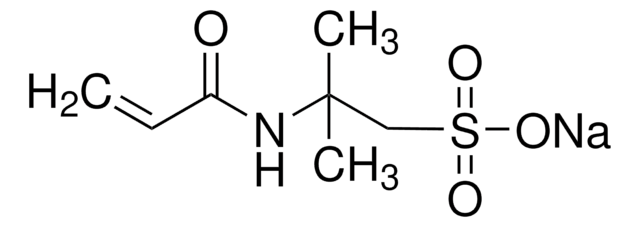If this product has an expiration or retest date, it will be shown on the Certificate of Analysis (COA, CofA). If there is no retest or expiration date listed on the product's COA, we do not have suitable stability data to determine a shelf life. For these products, the only date on the COA will be the release date; a retest, expiration, or use-by-date will not be displayed.
For all products, we recommend handling per defined conditions as printed in our product literature and website product descriptions. We recommend that products should be routinely inspected by customers to ensure they perform as expected.
For products without retest or expiration dates, our standard warranty of 1 year from the date of shipment is applicable.
For more information, please refer to the Product Dating Information document: https://www.sigmaaldrich.com/deepweb/assets/sigmaaldrich/marketing/global/documents/449/386/product-dating-information-mk.pdf
サイズを選択してください
About This Item
おすすめの製品
グレード
technical grade
品質水準
フォーム
liquid
濃度
30-40 wt. % in H2O
屈折率
n20/D 1.389
密度
1.267 g/mL at 25 °C
SMILES記法
[Na]OS(=O)(=O)C=C
InChI
1S/C2H4O3S.Na/c1-2-6(3,4)5;/h2H,1H2,(H,3,4,5);/q;+1/p-1
InChI Key
BWYYYTVSBPRQCN-UHFFFAOYSA-M
関連するカテゴリー
アプリケーション
- 超吸収性半相互侵入高分子網目(IPN)ヒドロゲルの調製。
- 全固体スーパーキャパシタの製造におけるプロトン伝導用固体電解質として。
- 多孔性配位高分子(CP)の高品質結晶の調製における結晶化制御剤として。PVSAは、結晶のサイズと構造だけでなく、結晶の優先配向も制御し、その結果、バルク粉末状態でCPチャネルが揃います。
シグナルワード
Warning
危険有害性情報
危険有害性の分類
Eye Irrit. 2 - Skin Irrit. 2 - STOT SE 3
ターゲットの組織
Respiratory system
保管分類コード
10 - Combustible liquids
WGK
WGK 3
個人用保護具 (PPE)
Eyeshields, Gloves, type ABEK (EN14387) respirator filter
適用法令
試験研究用途を考慮した関連法令を主に挙げております。化学物質以外については、一部の情報のみ提供しています。 製品を安全かつ合法的に使用することは、使用者の義務です。最新情報により修正される場合があります。WEBの反映には時間を要することがあるため、適宜SDSをご参照ください。
Jan Code
278424-1L:
278424-VAR:
278424-5ML:
278424-BULK:
278424-250ML:
この製品を見ている人はこちらもチェック
資料
Recently, layer-by-layer (LbL) assembly has emerged as a versatile, gentle and, simple method for immobilization of functional molecules in an easily controllable thin film morphology.1,2 In this short review, we introduce recent advances in functional systems fabricated by using the mild, yet adaptable LbL technique.
交互(LbL)積層法は、制御可能な形態を有する薄膜として機能性分子を固定するための汎用性の高い方法を提供します。
We present an article that discusses two applications in particular; first, using these layers as polyelectrolyte membranes to control permeability.
交互(LbL)積層法は非常に汎用性の高い手法であり、小型で機能的かつ多機能的な優れたコーティングを可能とします。
-
How can I determine the shelf life / expiration / retest date of this product?
1 回答-
役に立ちましたか?
-
-
How is shipping temperature determined? And how is it related to the product storage temperature?
1 回答-
Products may be shipped at a different temperature than the recommended long-term storage temperature. If the product quality is sensitive to short-term exposure to conditions other than the recommended long-term storage, it will be shipped on wet or dry-ice. If the product quality is NOT affected by short-term exposure to conditions other than the recommended long-term storage, it will be shipped at ambient temperature. As shipping routes are configured for minimum transit times, shipping at ambient temperature helps control shipping costs for our customers. For more information, please refer to the Storage and Transport Conditions document: https://www.sigmaaldrich.com/deepweb/assets/sigmaaldrich/marketing/global/documents/316/622/storage-transport-conditions-mk.pdf
役に立ちましたか?
-
-
What causes the difference between the yellow and amber colors of this product?
1 回答-
The quality specification for this item is only a residue on evaporation and appearance (color and form) assay for this technical grade product. Differences in color could be from numerous causes such as overall polymer composition, color perception, or appearance of raw material. It is not uncommon for the poly(styrenesulfonic acid sodium salt) to have color variations.
役に立ちましたか?
-
-
Hello, Just to confirm does the concentration of PVS vary from 30-40% in this raw material? Does 'Residue on evaporation' refer to the concentration of just PVS and not any impurities also in the raw material? I need to know the concentration of PVS.
1 回答-
Residue on evaporation refers to any solid material remaining after evaporating the water away. This value does not take into account potential impurities present in addition to the Poly(vinylsulfonic acid, sodium salt). Therefore, the concentration may vary slightly from the value provided on the lot-specific Certificate of Analysis.
Please access the link below to download a Certificate:
https://www.sigmaaldrich.com/product/aldrich/278424#product-documentation役に立ちましたか?
-
-
What is the pKa of this Poly(vinylsulfonic acid?
1 回答-
The pKa value is not determined for this product.
役に立ちましたか?
-
-
What is the average molecular weight of the SIgma Poly(vinylsulfonic acid, sodium salt)?
1 回答-
The molecular weight between 2000 and 5000 g/mol.
役に立ちましたか?
-
アクティブなフィルタ
ライフサイエンス、有機合成、材料科学、クロマトグラフィー、分析など、あらゆる分野の研究に経験のあるメンバーがおります。.
製品に関するお問い合わせはこちら(テクニカルサービス)












